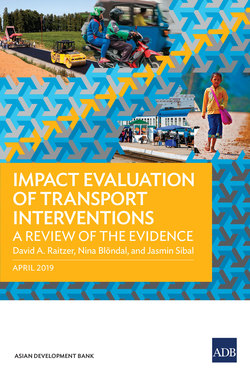Читать книгу Impact Evaluation of Transport Interventions - David A. Raitzer - Страница 6
Key Messages
ОглавлениеThere are important untested assumptions within traditional economic models of transport. For example, ex ante economic analysis models often mechanistically project that road improvements lead to increased vehicular speed, more productive time use, and reduced transport costs. Ex post analyses are usually based on before–after comparisons that assume that all changes over time are due to the road projects and not other trends or factors. This means that assumptions about how the roads are used and how users behave are often not directly tested. Understanding these behavioral aspects is critical to making transport investments more effective.
Impact evaluation can bring new evidence to transport design choices. The approach can test basic assumptions about effects of transport on travel speeds, transport costs, time savings, employment, prices, productivity, and welfare. It can also test new ways of doing transport interventions better and shed light on the role of complementary interventions, such as contracting arrangements, maintenance schemes, road safety initiatives, and incentives to shift to more sustainable modes of transportation. It also can test transport policies and effects on pollution and other environmental outcomes.
Transport investments have been subject to a growing number of impact evaluations. Transport has been a major sector for official development assistance. Yet, the evidence on the causal effects of transport sector interventions is relatively limited, compared with the social sectors. This is particularly true for sustainable transport investments, which often seek to change transport modes from private vehicles to public transit, make traffic behavior more efficient, or reduce excess travel. At the same time, a number of new and innovative impact evaluations have emerged in recent years, and the body of studies is growing rapidly. This review identifies 91 transport impact evaluations in developing countries, of which more than 65% have been published after 2012.
Impact evaluations to date have found effects on a range of outcomes. These include effects on income, poverty, employment, education, health, gender disparities, land prices, firm productivity, migration, and much more. Both significant expected effects have been found, as well as unanticipated outcomes. A striking pattern is that effects are variable across studies and contexts, and that impacts are more heterogenous than transport programming often assumes. The evidence offered is limited to specific contexts, periods, and types of interventions, and much of the evidence on these outcomes pertains to rural roads. More studies are needed to better understand factors conditioning effects observed.
Impact evaluations have focused increasingly on transport policies, in addition to infrastructure. A body of recent work has emerged, which evaluates a broader set of interventions, such as vehicle usage restrictions, safety interventions, and toll pricing on outcomes including driving behavior, congestion, local air pollution, and health. This new generation of impact evaluation often utilizes “big data,” multiple data sources, and automated data collection to capture new variables in innovative ways.
Impact evaluation of transport has special challenges. The nature of transport is inherently challenging for impact evaluation. Not only are there problems of nonrandom placement and large facilities with few treated units, but there are also other unique problems. Transport conditions the effects of location, so it has inherently heterogenous impacts. It can also condition location and cause populations of interest to shift. At the same time, a number of methods show promise for transport sector applications, which have not been used frequently. These include regression discontinuity designs, encouragement designs, and in some contexts, synthetic controls.
Randomized evaluations can offer evidence on a broader set of transport interventions. Although large transport infrastructure often cannot be randomly assigned, encouragement designs can introduce random variation in the use of transport facilities. These designs have untapped potential to enable testing of an expanded array of assumptions and interventions, especially through pricing encouragements.
“Open data” can enable new impact evaluation possibilities. High frequency, geospatial, and “crowdsourced” data are increasingly available, and many of these data sets are relevant to transport. For example, remote sensing can now detect road network development and pollution, and ride-sharing applications can enable vehicle speed monitoring in real time. Many recent impact evaluations have started to use automatically collected data from traffic detection systems, air pollution monitors, public transit monitors, and even license plate recognition technology. These developments expand the number of impact evaluation possibilities.
There are important transport evidence gaps that future studies can address. Impact evaluation has given relatively little coverage to major areas of investment, such as urban and sustainable transportation, major transport corridors, and efficiency enhancing measures. Effects via access to public services and prices have also had little investigation. Even where evidence exists, it is often limited to a few countries and programs. With new methods and increasing openness of geospatial data, there is scope for generating more innovative impact studies.
